The new analysis reveals that the inherent value of Geographic Information Systems (GIS) is well understood by AEC firms, and those that use it report achieving important benefits. Even firms and individuals currently not using GIS have a favorable view of its potential, according to the report released by Dodge Data & Analytics.
Those benefits include improved productivity and client satisfaction, the ability to offer more services; reduced conflicts, field coordination problems, or changes during construction; and increased ability to manage project complexity.
The report states that designers and contractors also see value in their entire teams using GIS data, especially when that sharing engages owners. But when using GIS across project teams, interoperability is key to sustaining contractor and designer workflows. The report notes that the industry has been investing in training to find qualified staff to manage GIS.
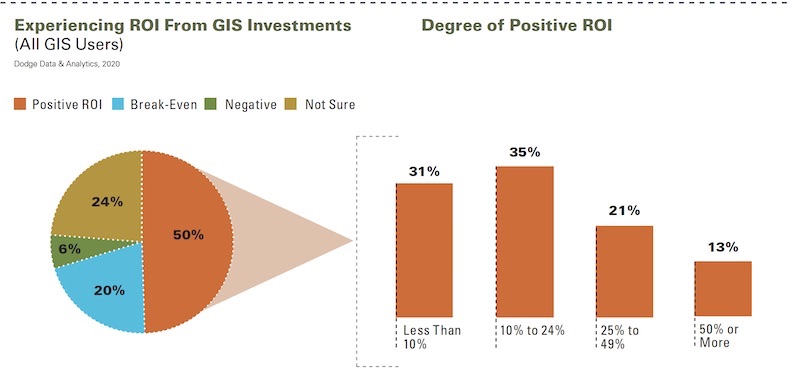
A strong majority of respondents are experiencing double-digit returns on investment from using ROI.
The data and analysis in this report—titled “The Business Value of GIS for Design and Construction”—are based on responses to an online survey conducted in August and September 2020. The survey’s 473 respondents include 228 architects, 43 civil or structural engineers, 33 engineering consultants, 113 GCs or CMs, and 56 specialty trade contractors.
Respondents were eligible to take the survey if they had experience in using relevant software, such as CAD drafting, 2- and 3-D modeling apps, data visualization and mapping, and/or collaboration tech or project management software.
The report includes interviews with Donna Huey, Senior Vice President and Director of Client Technologies at Atkins North America; Cory Dippold, PE, Vice President-Special Projects Applications, Mott MacDonald; and Sanjay Kumar, founder and CEO, Geospatial Media and Communications.
Access to the Dodge report requires registration. Autodesk and Esri provided funding and support for the report.
ROI CONNECTED TO FREQUENCY OF USE
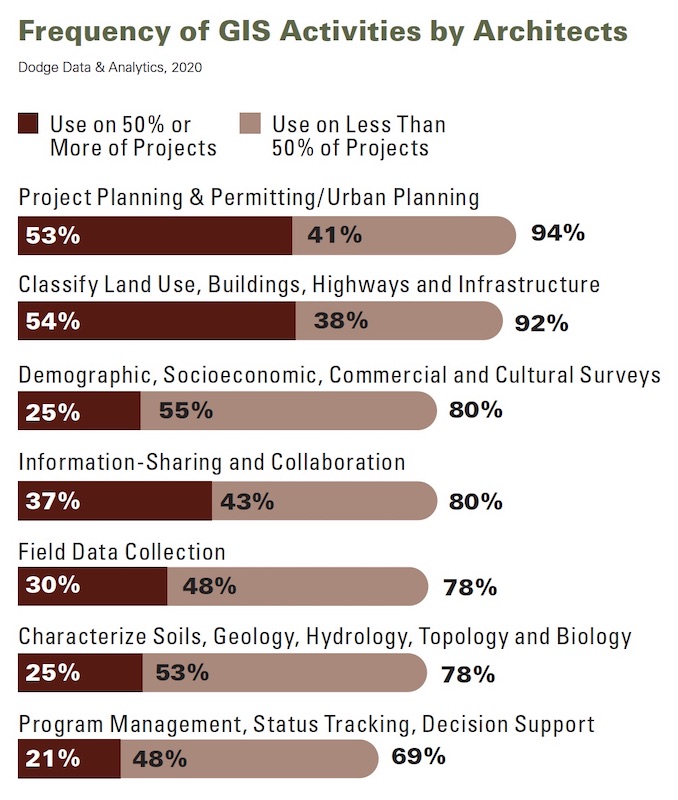
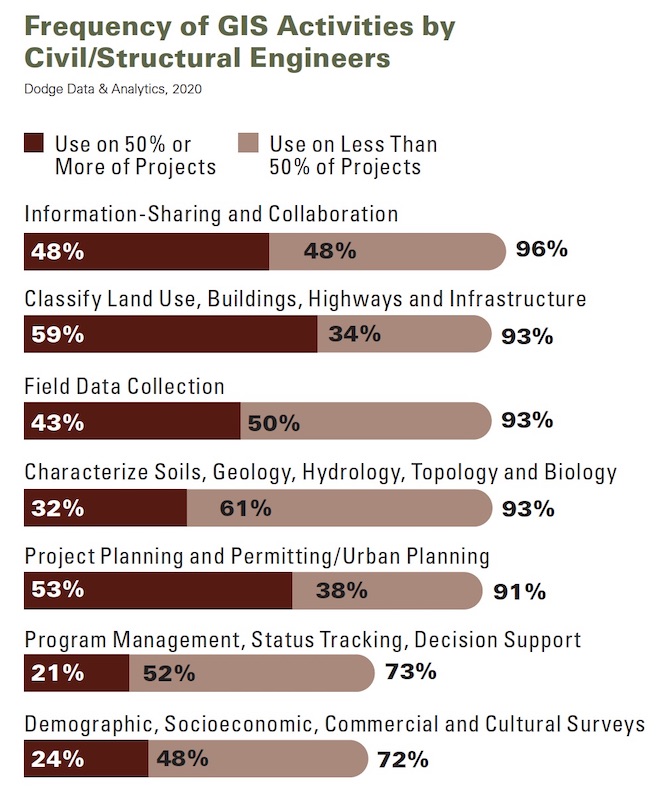
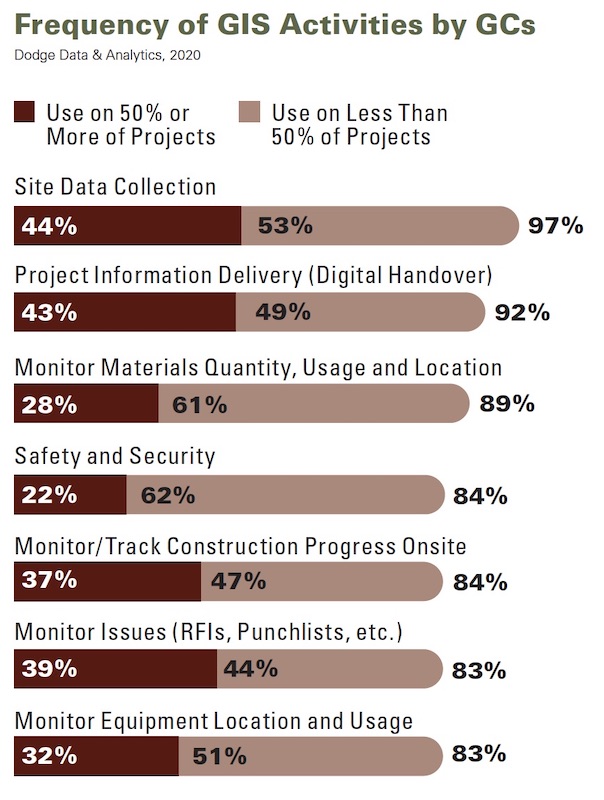
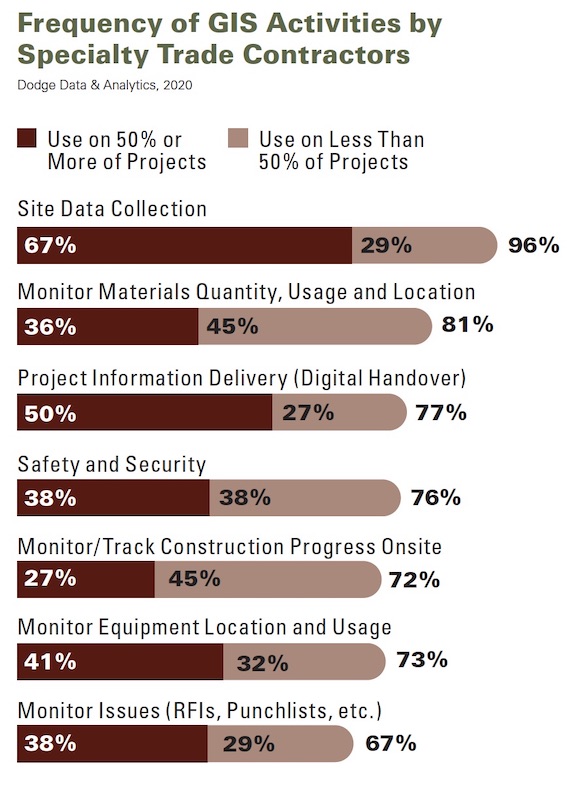
The charts above show the frequency of GIS usage by company type, and illustrate how each company's priorities differ in GIS's application.
The Dodge report touches specifically on the integration of GIS and BIM, the benefits of GIS on project processes and outcomes, and how GIS helps reduce risk and enhance a project’s sustainability and disaster resilience. Client satisfaction is at the top of respondents’ list of market-related benefits from using GIS. Digital tools like GIS are also helping AEC firms keep jobsites safe and productivity high during the coronavirus pandemic.
Over the past three years, more than half of the survey’s respondents said their companies had invested in software that supports the use of GIS, and 36% said they’d invested in training, too, during that period. Among the 50% of respondents who say they’ve experienced positive returns on their investments, nearly 70% estimates that the degree of positive returns exceeds 10%.
The report implies a connection between ROI and the frequency of GIS use by project team members. Nearly two-fifths (38%) of the architects who replied to the survey state that on at least half of their projects, other design firms or consultants on the design team use GIS.
INTEROPERABILITY STILL PROBLEMATIC
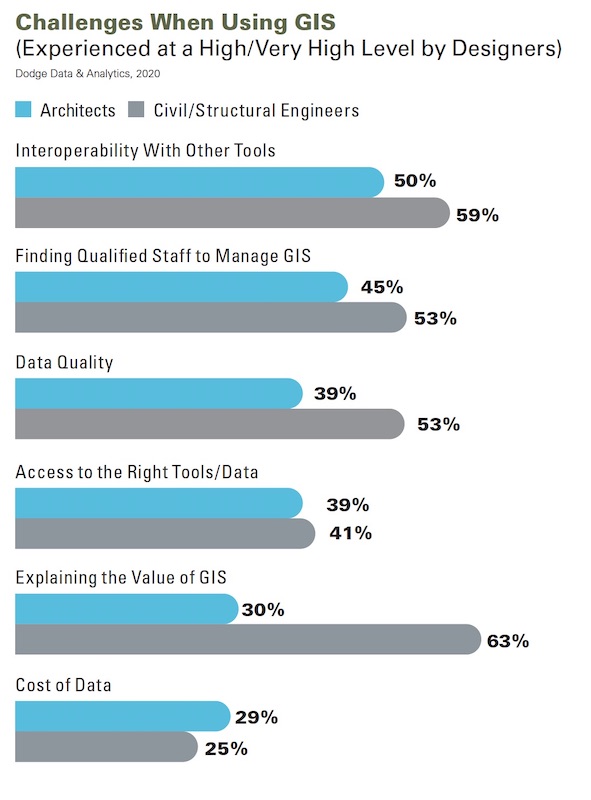
Using GIS with other digital tools, and finding people who are familiar with the software, pose limits to its wider application, especially when it comes to sharing data with teams.
Engineers state that owners now expect the design team to provide updates back to the GIS as part of the collaborative process during design. And nearly all contractors surveyed (at least 96%) report that a project’s GC is either using GIS or takes advantage of GIS in design documents. For contractors, the most valuable engagement is when the design team has used GIS in its design.
Interoperability with other digital tools, however, continues to be the biggest roadblock to greater use of GIS; at least half of the architects and engineers surveyed cited this as a challenge. Other impediments include finding qualified staff, the quality of the data, and access to the right tools for projects. Finding staff is the greatest challenge for contractors and specialty trades.
Better interoperability, in fact, would drive greater use of GIS, say 54% of the survey’s respondents. Another driver would be more accurate and reliable GIS information, say 36% of respondents.
Data quality is particularly critical when AEC firms deploy tools like GIS and BIM in their smart city projects. If a building is viewed as a system, and a city a system of systems, then “The marriage of BIM and GIS makes data exchange possible across those levels of scale,” the report states. “The potential is huge,” adds Scott Edmondson, a senior planner and economist with San Francisco Planning’s data analytics group.
This marriage is less about creating a digital twin of a city than it is about making incremental improvements to existing conditions within a city, observed Stephen Brockwell, senior product owner at Esri. With data integrations across BIM and GIS, “dynamic, thriving cities have never been more possible,” said Brockwell.
EVEN NONUSERS ARE COGNIZANT OF BENEFITS
If GIS is such a great tool, what’s keeping more AEC firms form using it? There was a small group of nonusers among the survey’s respondents, and 13% of them expressed no interest in using GIS in the future, citing the lack of real application for what they do, or not enough client demand.
Conversely, 87% of nonusers say they are aware of GIS’s benefits. Fifty-five percent of nonusers say they are open to exploring GIS’s potential value to their firms.
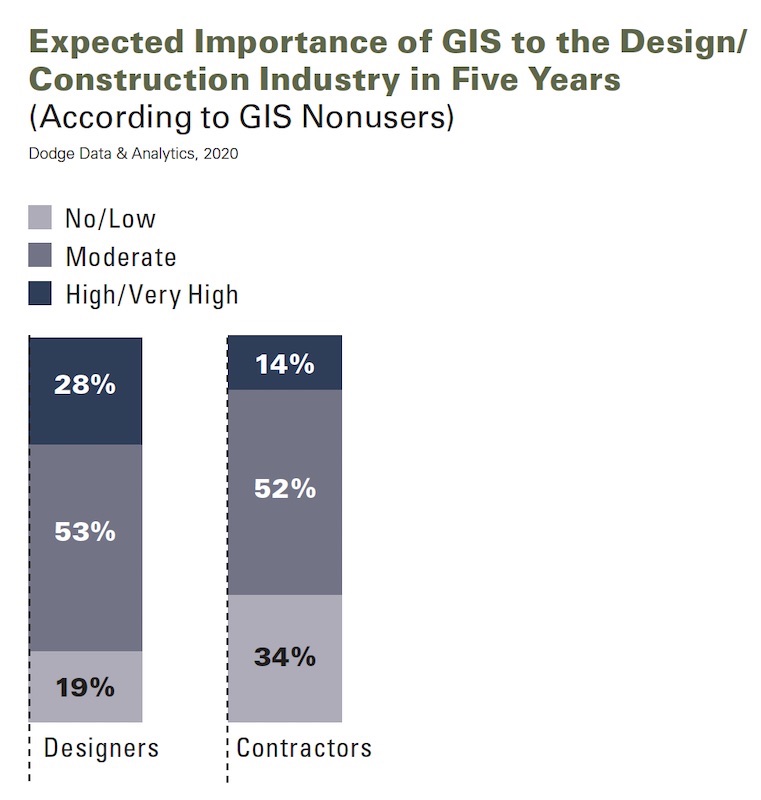
Designers are more sanguine about the future relevance of GIS for their business sector.
The extent that competitors are using GIS might eventually drive nonusers to give the tool a tryout. Other influencers for designers include improved field data collection during planning and design, and improved product understanding among stakeholders. For contractors, the biggest influence for adopting GIS is reducing the number and need for RFIs and change orders, followed by improved collaboration across and within teams.
The benefits most likely to influence adoption of GIS are led, for designers and contractors alike, by improved productivity.
While designers are generally far more enthusiastic about the importance of GIS in five years, it is clear, according to the Dodge report, that the majority of designers and contractors not using GIS currently expects it to be at least moderately important to the industry in the near future.
Related Stories
Sustainability | May 1, 2023
Increased focus on sustainability is good for business and attracting employees
A recent study, 2023 State of Design & Make by software developer Autodesk, contains some interesting takeaways for the design and construction industry. Respondents to a survey of industry leaders from the architecture, engineering, construction, product design, manufacturing, and entertainment spheres strongly support the idea that improving their organization’s sustainability practices is good for business.
AEC Tech | May 1, 2023
Utilizing computer vision, AI technology for visual jobsite tasks
Burns & McDonnell breaks down three ways computer vision can effectively assist workers on the job site, from project progress to safety measures.
AEC Tech Innovation | Apr 27, 2023
Does your firm use ChatGPT?
Is your firm having success utilizing ChatGPT (or other AI chat tools) on your building projects or as part of your business operations? If so, we want to hear from you.
Design Innovation Report | Apr 19, 2023
HDR uses artificial intelligence tools to help design a vital health clinic in India
Architects from HDR worked pro bono with iKure, a technology-centric healthcare provider, to build a healthcare clinic in rural India.
Resiliency | Apr 18, 2023
AI-simulated hurricanes could aid in designing more resilient buildings
Researchers at the National Institute of Standards and Technology (NIST) have devised a new method of digitally simulating hurricanes in an effort to create more resilient buildings. A recent study asserts that the simulations can accurately represent the trajectory and wind speeds of a collection of actual storms.
3D Printing | Apr 11, 2023
University of Michigan’s DART Laboratory unveils Shell Wall—a concrete wall that’s lightweight and freeform 3D printed
The University of Michigan’s DART Laboratory has unveiled a new product called Shell Wall—which the organization describes as the first lightweight, freeform 3D printed and structurally reinforced concrete wall. The innovative product leverages DART Laboratory’s research and development on the use of 3D-printing technology to build structures that require less concrete.
Smart Buildings | Apr 7, 2023
Carnegie Mellon University's research on advanced building sensors provokes heated controversy
A research project to test next-generation building sensors at Carnegie Mellon University provoked intense debate over the privacy implications of widespread deployment of the devices in a new 90,000-sf building. The light-switch-size devices, capable of measuring 12 types of data including motion and sound, were mounted in more than 300 locations throughout the building.
Architects | Apr 6, 2023
New tool from Perkins&Will will make public health data more accessible to designers and architects
Called PRECEDE, the dashboard is an open-source tool developed by Perkins&Will that draws on federal data to identify and assess community health priorities within the U.S. by location. The firm was recently awarded a $30,000 ASID Foundation Grant to enhance the tool.
AEC Tech | Mar 14, 2023
Skanska tests robots to keep construction sites clean
What if we could increase consistency and efficiency with housekeeping by automating this process with a robot? Introducing: Spot.
Modular Building | Mar 3, 2023
Pallet Shelter is fighting homelessness, one person and modular pod at a time
Everett, Wash.-based Pallet Inc. helped the City of Burlington, Vt., turn a municipal parking lot into an emergency shelter community, complete with 30 modular “sleeping cabins” for the homeless.

















